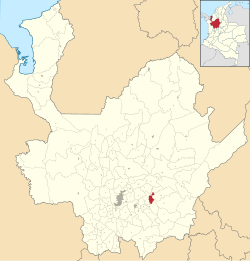Guatapé
Municipality and town in Antioquia Department, Colombia From Wikipedia, the free encyclopedia
Municipality and town in Antioquia Department, Colombia From Wikipedia, the free encyclopedia
Guatapé is a town and municipality in the Department of Antioquia, Colombia.[1] It is a part of the subregion of Eastern Antioquia and is located 79 kilometres (49 mi) from Medellín, the capital of the department. Guatapé is bordered on the north by Alejandría, San Rafael to the east, and Granada and El Peñol to the south. This town is the gathering place for Las Vegas, referring to the small farms of the area.
Guatapé | |
|---|---|
Municipality and town | |
 Aerial image of Guatapé and in the background the Piedra del Peñol | |
 Location of the municipality and town of Guatapé in the Antioquia Department of Colombia | |
| Country | |
| Department | |
| Subregion | Eastern |
| Elevation | 1,890 m (6,200 ft) |
| Demonym(s) | Guatapenses Guatapeños |
| Time zone | UTC-5 (Colombia Standard Time) |
It lies at an altitude of 1,890 meters above sea level.
The town is a major tourist attraction, especially for travelers from Medellín. El Peñón de Guatapé, a large rock that visitors can climb, and the famous zócalos (murals) that adorn several buildings attract many tourists.
Before Spanish conquistadores reached the area in the 16th century, this territory was inhabited by indigenous groups, some controlled by a cacique named Guatapé. In his honor, the town was named after him. The name "Guatapé", comes from the Quechua language, related to "stones and water". Another name that the town had in the past was "La Ceja de Guatapé".
In 1714, the indigenous people under Guatapé of this region were grouped into a shelter known as "San Antonio de Remolinos Peñol". Traces of their existence come from clay urns found in the town of Alto Verde, and several archaeological sites not yet studied in the villages of La Peña, La Piedra, El Roble, and El Rosario.
Guatapé was founded on 4 October 1811, by the Spaniard Don Francisco Giraldo y Jimenez. It was declared a municipality in September 1867.
Guatapé has changed throughout its history. It was predominantly a farming town that relied on livestock, agriculture, and mining. Empresas Públicas de Medellín built a large hydroelectric complex here in the 1970s. This megaproject produced large impacts on social, economic, political, environmental, and cultural development in the locality. With the construction of this dam, Guatapé became one of the most important electric production centers in the country.
The neighboring town of El Peñol and rural parts of Guatape were destroyed as a result of the flooding of valley which created the El Peñol-Guatapé reservoir, displacing thousands of residents and resulting in the forced evacuation and rebuilding of the town a few miles west of its former location.[2]
Total Population: 6,469 inhabitants (2015)
Literacy: 92.3% (2005)
Ethnicity: According to figures presented by DANE census in 2005, the ethnic makeup of the township is the following:


El Peñón de Guatapé is a rock formation that borders a lake. It formed along the Antioquia Rock Base (batolito de antioquia), 70 million years ago. With two-thirds of its height below ground, the exposed vertical face is over 200 meters high and visible from throughout the surrounding countryside. Visitors can scale the rock via a staircase built into one side, a path that includes more than 708 steps to the top.[3]
Each building has tiles along the facade's lower walls in bright colors and dimensioned images. Many of the tiles are tied to the products sold by the shops, or the beliefs of the residents. Others are cultural images of the farming heritage of the community.
Seamless Wikipedia browsing. On steroids.
Every time you click a link to Wikipedia, Wiktionary or Wikiquote in your browser's search results, it will show the modern Wikiwand interface.
Wikiwand extension is a five stars, simple, with minimum permission required to keep your browsing private, safe and transparent.